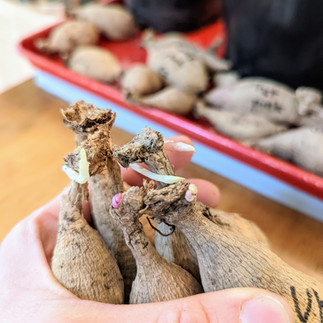Thinking ahead with Dahlias
- Laura Morris
- Aug 29, 2022
- 3 min read
Updated: Sep 11, 2022

Dahlias are beautiful flowers that take some effort to maintain. If you are growing dahlias this year, depending on your zone, you should have full plants, maybe some with blooms just emerging and some with already abundant blooms.
As you enjoy your dahlias this year, you may already be thinking ahead to next year and what new varieties or colors you want to plant. You may also be wondering about how best to continue caring for your dahlias come winter.
Dahlias are interesting plants because they are grown from tubers. In order to get a specific variety of dahlia, you need to get your hands on a tuber or cutting from the variety you want to plant. You cannot grow a specific variety of dahlia from seed from that plant. A seed will produce an entirely new variety. In fact, each seed from a dahlia will produce a different dahlia plant.

Dahlias are native to Mexico where they perennialize. They thrive in hot weather. When tubers freeze, they turn to mush. Hence, gardeners and farmers in zones 3-7 will need to dig up their tubers each year. Tubers will need to be stored, divided, and replanted in the spring.
There is an exception to this. Some farmers in zone 7 have found that by cutting the dahlias back and protecting the tubers over the winter with mulch and layers of plastic or frost cloth, the dahlias are able to overwinter and pop up much sooner in the spring, ready to grow. They get flowers earlier and can have healthier plants. However, if left over multiple years, the tubers will grow so big and become so entangled that it is hard to separate them. It is suggested that you dig up your overwintered dahlias every other year to divide them.

As your dahlias flower this summer and fall, keep cutting the blooms and deadheading. Make sure to cut deeply into the plant to harvest blooms. If you leave the spent blooms on the plants, this will signal to the plant to start making seeds. Your dahlia plant will begin moving from flowering into seed production.
If you are interested in hybridizing dahlias, you will want your dahlia plant to move into seed production at some point. There are a few different ways to try to hybridize dahlias. The easiest way is to let the bees take care of it. To do this, remove from your farm or garden any dahlias that have traits that you do not want to replicate. This usually includes flowers with low petal counts, weak stems, open centers, and downward facing blooms. Each of these traits is dominant to the genetics of dahlias. Keep in your flower beds dahlias with high petal counts in colors that you prefer and flowers with strong stems that face upward. However, you will want to remove any open blooms because those blooms could have been pollinated with pollen from the plants you just discarded. Leave tight buds to open. After the bees have had access to the flowers, let the flowers fade. The petals will fall off, and a straw-like seed pod will form. This needs to dry out on the plant. You can collect the pod and label it with the parent plant. Save the seeds and replant them in the spring. It is exciting to see what you get. Below are dahlias that came from seeds I collected last year.
You can see the seed pods of the dahlias below. On the plant to the left, they are conical instead of round.

I recommend making yourself aware of different farms that sell tubers. Some farms have a fall sale and will ship in the spring. Most dahlia sellers will sell tubers in the spring when they have a specific inventory. One of my favorite places to look for tubers is Triple Wren Farms, but I also encourage you to search for small farms in your area that have an abundance of tubers. Coseytown Flowers hybridizes dahlias and has some beautiful varieties. Stonehouse Dahlias sells rooted cuttings of Kristine Albrecht's beautiful dahlias. Dahlia Addict is a great resource for those looking for specific varieties.
If you are interested in more information about hybridizing dahlias and other methods to get a specific cross between two flowers, make sure to check out Kristine Albrecht's Instagram account and her book.
Below are tubers that have been dug up and rinsed, ready for dividing; divided tubers in a pot to begin sprouting in the spring, and baby sprouts coming from the eyes in the tubers.
I have more posts to come later this fall about digging up your dahlias, dividing them, and storing them.



















Comments